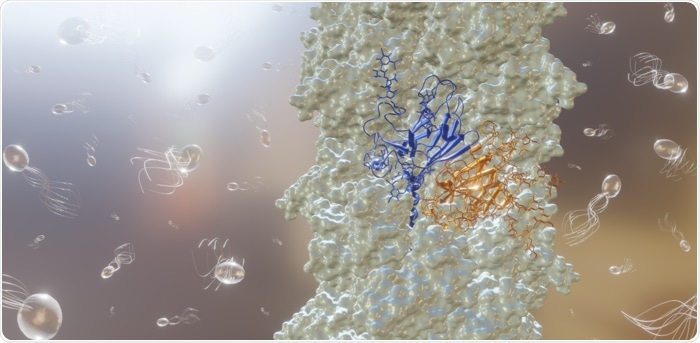Archaea, like bacteria, may be found in a wide range of environments, including inside human bodies, although they are not known to cause illness.

Representation of the M. villous archaellum highlighting the two alternating subunits in blue and orange (foreground) and swimming M. villosus cells (background). Image Credit: University of Exeter.
Some archaea propel themselves at tremendous speeds by revolving an archaellum, a spiral-shaped thread.
The new study looked at this in greater detail than ever before, thanks to a sophisticated cryo-electron microscope.
Methanocaldococcus villosus, a species found near undersea volcanoes off the coast of Iceland, where water temperatures may exceed 80 °C—was the focus of the study team that included the University of Regensburg.
M. villosus swims at a speed of about 500 body lengths per second. Considering that the tiny cell is only about one micrometer in size, this means half a millimeter in one second. At first glance, this does not seem much. But in comparison, a cheetah achieves only 20 body lengths per second—so if an M. villosus cell had the size of a cheetah, it would swim at approximately 3,000 kilometers per hour.
Dr Lavinia Gambelli, Living Systems Institute, University of Exeter
Dr Lavinia Gambelli adds, “The incredible speed that M. villosus can achieve makes it one of the fastest organisms on the planet.”
Researchers can view things as tiny as a few hydrogen atoms in width using a cryo-electron microscope.
At this resolution, we can see the very fabric of life and study fundamental biological processes at atomic detail. In this study, we were able to look closely at the smallest propeller in the world, to find out more about its shape and how it works. As well as teaching us more about these fascinating organisms, this could have implications for human health and technology.”
Dr Bertram Daum, Living Systems Institute, University of Exeter
“Archaea make up a considerable percentage of the microorganisms found in the human body. None has so far been found to cause disease, but it remains a possibility. In the future, it might even be possible to develop microscopic robotic devices for drug delivery based on the tiny propellers used by archaea,” remarks Dr Bertram Daum.
The researchers observed that M. villosus filaments are built of thousands of copies of two alternating proteins, whereas previously studied filaments had only one protein.
This shows that an archaellum’s design and assembly are more complicated than originally anticipated.
The scientists also discovered two critical structural features that allow the archaellum filament to mobilize and drive the cell at a rapid rate.
Source:
Journal reference:
Gambelli, L., et al. (2022) An archaellum filament composed of two alternating subunits. Nature Communications. doi.org/10.1038/s41467-022-28337-1.